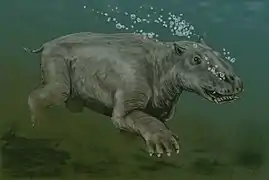Paleoparadoxia
Paleoparadoxia (« l'ancien paradoxe ») est un genre éteint de mammifères placentaires, herbivores et aquatiques appartenant à l'ordre des Desmostylia. Ses fossiles montrent qu'il a vécu sur la côte nord du Pacifique (Japon, Californie) durant une partie du Miocène, du Langhien au Tortonien, soit il y a environ entre 15,97 à 7,246 millions d'années [1].

| Règne | Animalia |
|---|---|
| Embranchement | Chordata |
| Sous-embr. | Vertebrata |
| Classe | Mammalia |
| Cohorte | Placentalia |
| Super-ordre | Afrotheria |
| — non classé — | Paenungulata |
| — non classé — | Tethytheria |
| Ordre | † Desmostylia |
| Famille | † Paleoparadoxiidae |
Espèces de rang inférieur
- † Paleoparadoxia tabatai Tokunaga, 1939, espèce type[2] - [3]
- † Paleoparadoxia media Inuzuka, 2005
Description
On pense que Paleoparadoxia se nourrissait principalement d'algues et d'herbes marines. Les mâchoires et l'angle des dents ressemblent à un godet d’excavatrice. Son corps volumineux était bien adapté à la nage et à la recherche de nourriture sous l'eau. À l'origine interprété comme amphibie, Paleoparadoxia est maintenant considérée comme un mammifère entièrement marin comme ses parents actuels, les siréniens, qui passent la majeure partie de leur vie à marcher sur le fond de la mer comme des hippopotames marins, mais ne sont pas adaptés à la plongée profonde ni à la sortie en pleine mer[4].
Classification
Tokunaga a décrit l'espèce Cornwallius tabatai en 1939 et Reinhart l'a transférée en 1959 au genre Paleoparadoxia[5].
Selon le site Web Paleobiology Database (en ) deux espèces éteintes sont incluses dans le genre[6]:
- Paleoparadoxia media (Inuzuka 2005)
- Paleoparadoxia tabatai (Tokunaga 1939)
Notes et références
- (en) R. H. Reinhart. 1959. A review of the Sirenia and Desmostylia. University of California Publications in Geological Sciences 36(1):1-146
- (en) « Yoshiwara, Shigeyasu », Sirenia.org (consulté le )
- (en) Kumiko Matsui; Katsuo Sashida; Sachiko Agematsu; Naoki Kohno, « Habitat preferences of the enigmatic Miocene tethythere Desmostylus and Paleoparadoxia (Desmostylia; Mammalia) inferred from the depositional depth of fossil occurrences in the Northwestern Pacific realm », Palaeogeography, Palaeoclimatology, Palaeoecology, no 471, , p. 254–265 (ISSN 0031-0182, DOI 10.1016/j.palaeo.2017.02.005)
- Kumiko Matsui, Katsuo Sashida, Sachiko Agematsu et Naoki Kohno, « Habitat preferences of the enigmatic Miocene tethythere Desmostylus and Paleoparadoxia (Desmostylia; Mammalia) inferred from the depositional depth of fossil occurrences in the Northwestern Pacific realm », Palaeogeography, Palaeoclimatology, Palaeoecology, vol. 471, , p. 254–265 (ISSN 0031-0182, DOI 10.1016/j.palaeo.2017.02.005, lire en ligne, consulté le )
- « Opinion 2232 (Case 3384) Cornwallius tabatai Tokunaga, 1939 (currently Paleoparadoxia tabatai; Mammalia, Desmostylia): proposed designation of a neotype not accepted », The Bulletin of Zoological Nomenclature, vol. 66, no 3, , p. 295–296 (ISSN 0007-5167, DOI 10.21805/bzn.v66i3.a11, lire en ligne, consulté le )
- « PBDB », sur paleobiodb.org (consulté le )
- (en) Cet article est partiellement ou en totalité issu de l’article de Wikipédia en anglais intitulé « Paleoparadoxia » (voir la liste des auteurs).
Voir aussi
Références taxinomiques
- (en) Référence BioLib : Paleoparadoxia Reinhart, 1959 † (consulté le )
- (en) Référence Paleobiology Database : Paleoparadoxia Reinhart, 1959 † (consulté le )
- (en) Référence uBio : site déclaré ici indisponible le 7 avril 2023